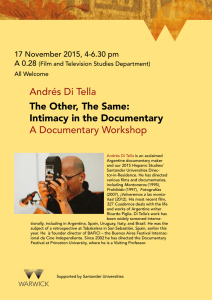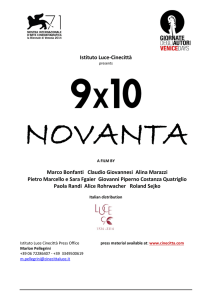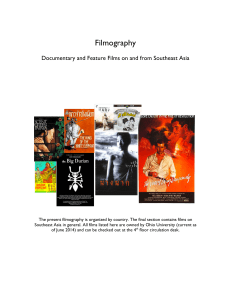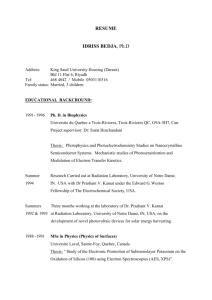Documentary photography and film in Italy: critical debates and
advertisement
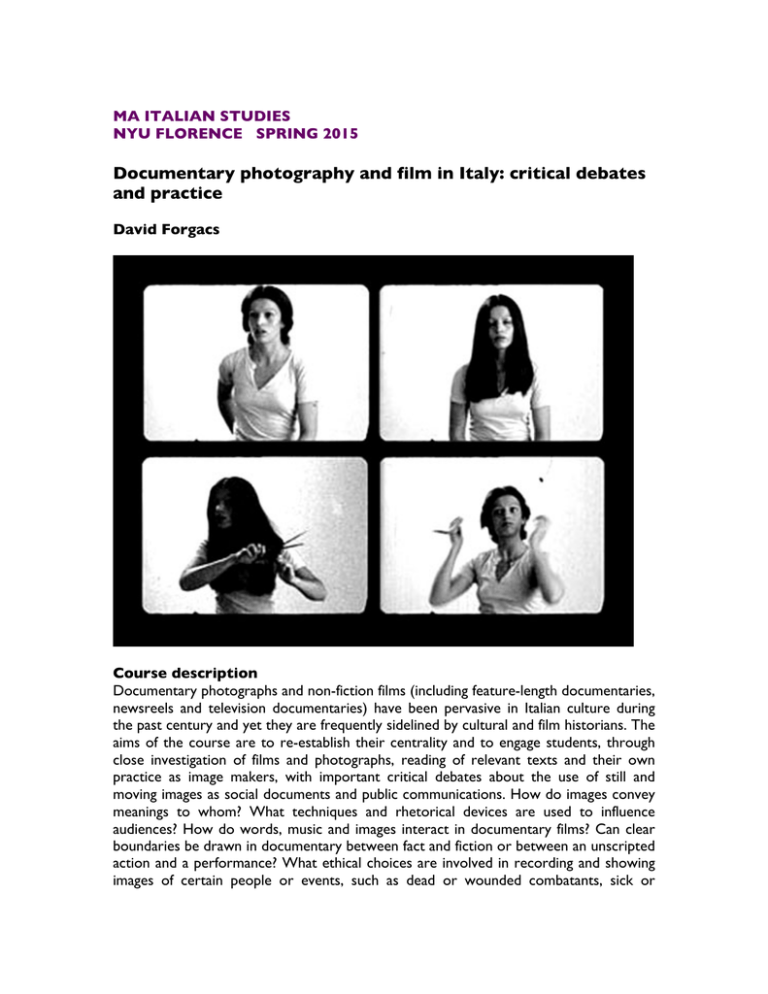
MA ITALIAN STUDIES NYU FLORENCE SPRING 2015 Documentary photography and film in Italy: critical debates and practice David Forgacs Course description Documentary photographs and non-fiction films (including feature-length documentaries, newsreels and television documentaries) have been pervasive in Italian culture during the past century and yet they are frequently sidelined by cultural and film historians. The aims of the course are to re-establish their centrality and to engage students, through close investigation of films and photographs, reading of relevant texts and their own practice as image makers, with important critical debates about the use of still and moving images as social documents and public communications. How do images convey meanings to whom? What techniques and rhetorical devices are used to influence audiences? How do words, music and images interact in documentary films? Can clear boundaries be drawn in documentary between fact and fiction or between an unscripted action and a performance? What ethical choices are involved in recording and showing images of certain people or events, such as dead or wounded combatants, sick or vulnerable adults, minors? Students will be required to make close analyses, in class and outside, of photographs and selected films and assigned readings of critical texts. They will also be invited to make their own photographic or video diary or project as part of the learning process (no previous experience of this is required). The course will be assessed by a final paper and optional visual project. Selected films La guerra d’Italia a 3000 metri sull’Adamello (Luca Comerio, 1916, 11’) La fondazione della nuova Addis Abeba (G. Martucci, 1939, 20’) Giorni di gloria (Giuseppe De Santis, Marcello Pagliero, Mario Serandrei, Luchino Visconti, 1945, 71’) Tentato suicidio (Michelangelo Antonioni, 22’, episode of Gli amori in città, 1953) La “menzogna di Marzabotto” (Carlo Di Carlo, 1961, 20’) Comizi d’amore (Pier Paolo Pasolini, 1964, 90’) All’armi, siam fascisti! (Lino Del Fra, Cecilia Mangini, Lino Micchiché, 1962, 94’) Essere donne (Cecilia Mangini, 1965, 28’) Matti da slegare (Silvano Agosti, Marco Bellocchio, Sandro Petraglia, Stefano Rulli, 1976, 135’) Vogliamo anche le rose (Alina Marazzi, 2007, 84’) Come un uomo sulla terra (Andrea Segre, Dagmawi Yimer, Riccardo Biadene, 2008, 56’) Lo stato della follia (Francesco Cordio, 2013, 72’) Selected reading (students should read items marked * before starting the course) *Aufderheide, Patricia, Documentary film: a very short introduction, Oxford ; New York, 2007 *Barthes, Roland, Camera Lucida, New York, Hill and Wang, 1981 (tr. of La Chambre claire, Paris: Gallimard, 1980) Bertozzi, Marco, Storia del documentario italiano. Immagini e culture dell'altro cinema, Venezia: Marsilio, 2008. Corner, John, The Art of Record: a critical introduction to documentary, Manchester University Press, 1996. Cousins, Mark and Kevin MacDonald (eds), Imagining Reality: The Faber Book of Documentary, London: Faber, 2006. Geiger, Jeffrey, “Fiction, Truth, and the Documentary Contract,” in Jeffrey Geiger and R.L. Rutsky (eds), Film analysis: A Norton Reader, New York: Norton, 2005 Nichols, Bill, Representing Reality: Issues and Concepts in Documentary, Bloomington: Indiana University Press, 1991. Plantinga, Carl R., Rhetoric and Representation in Nonfiction Film, Cambridge University Press, 1997. Rabinowitz, Paula, They Must be Represented: The Politics of Documentary, New York: Verso, 1994 Renov, Michael, The Subject of Documentary, Minneapolis: University of Minnesota Press, 2004. *Sontag, Susan, On Photography, New York: Farrar, Straus and Giroux, 1977. Tagg, John, The Burden of Representation: Essays on Photographies and Histories, University of Minnesota Press,1988. 2
